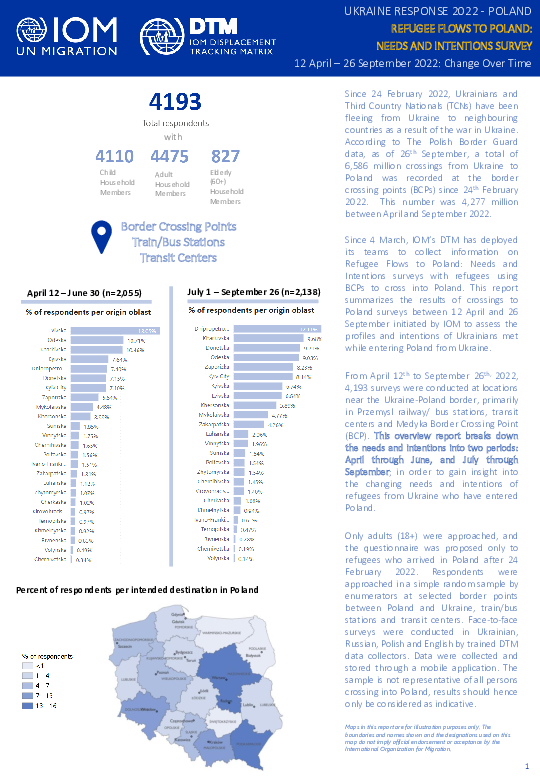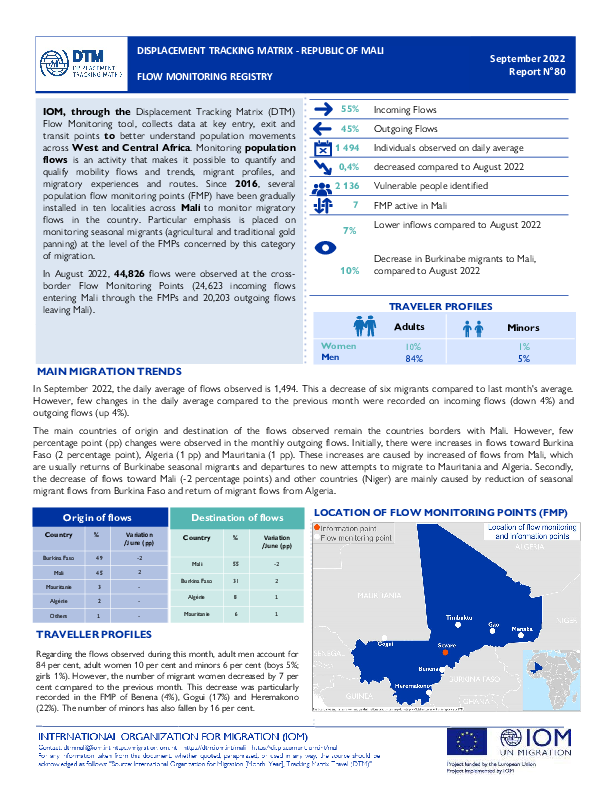-
Countries
-
Data and Analysis
-
Special Focus
-
Crisis Responses

Contact
DTM Europe, DTMMediterranean@iom.int
Language
English
Location
Poland
Period Covered
Apr 12 2022
Sep 26 2022
Activity
- Survey
- Community Perception
Since 4 March, IOM’s DTM has deployed its teams to collect information on Refugee Flows to Poland: Needs and Intentions surveys with refugees using BCPs to cross into Poland. This report summarizes the results of crossings to Poland surveys between 12 April and 26 September initiated by IOM to assess the profiles and intentions of Ukrainians met while entering Poland from Ukraine.
From April 12th to September 26th, 2022, 4,193 surveys were conducted at locations near the Ukraine-Poland border, primarily in Przemysl railway/bus stations, transit centers and Medyka Border Crossing Point (BCP). This overview report breaks down the needs and intentions into two periods: April through June, and July through September; in order to gain insight into the changing needs and intentions of refugees from Ukraine who have entered Poland.

Contact
DTM Pakistan, iomisbdtmremapteam@iom.int
Language
English
Location
Pakistan
Period Covered
Sep 27 2022
Oct 07 2022
Activity
- Flow Monitoring
IOM Pakistan collects data on the outflows of undocumented Afghan migrants at the Torkham and Chaman border crossing points in an effort to better understand the migration movements of undocumented Afghan migrants returning to Afghanistan from
Pakistan. This exercise is part of the European Union funded project “Displacement Tracking Matrix Regional Evidence for Migration Analysis and Policy (DTM REMAP)”. From 24 Sep. to 7 Oct. 2022, 2,884 undocumented Afghan migrants returned to Afghanistan from Pakistan, including 410 through the Torkham border point and 2,508 through the Chaman border point. During the reporting period, border authorities facilitated the return of 240 individuals due to the lack of legal documentation
to remain in Pakistan. Therefore, information concerning these 240 individuals is not included in the report analysis.

Contact
DTM Pakistan, iomisbdtmremapteam@iom.int
Language
English
Location
Pakistan
Period Covered
Sep 10 2022
Sep 23 2022
Activity
- Flow Monitoring
IOM Pakistan collects data on the outflows of undocumented Afghan migrants at the Torkham and Chaman border crossing
points in an effort to better understand the migration movements of undocumented Afghan migrants returning to Afghanistan from
Pakistan. This exercise is part of the European Union funded project “Displacement Tracking Matrix Regional Evidence for Migration Analysis and Policy (DTM REMAP)”.
From 10 Sep to 23 Sep 2022, 2,918 undocumented Afghan migrants returned to Afghanistan from Pakistan, including 410 through the Torkham border point and 2,508 through the Chaman border point. During the reporting period, border authorities facilitated the return of 65 individuals due to the lack of legal documentation to remain in Pakistan. Therefore, information concerning these 65 individuals is not included in the report analysis.
Contact
DTM Burundi, DTMBurundi@iom.int
Location
Burundi
Activity
- Mobility Tracking
- Event Tracking
Period Covered
Oct 19 2022 -Oct 23 2022
Activated on an ad hoc basis, the DTM Emergency Tracking provides early field reports at the beginning of a complex crisis, allowing IOM to gather, consolidate and disseminate baseline information on displacement and return figures at the onset of a newly emerging crisis. The DTM Emergency Tracking relies heavily on information provided by RARTs or partners within the humanitarian community about an unfolding situation. The Emergency Tracking gathers data through IOM Burundi’s extended network of key informants, who provide basic information on the new displacement, be it of IDPs or returnees, or both, including numbers, location and shelter types. While IOM DTM strives to provide best estimates, the Emergency Tracking aims to be a quick monitoring tool with real-time data turnover ranging from 24 to 72 hours following its activation.
Population Groups
Survey Methodology
Unit of Analysis Or Observation
Type of Survey or Assessment
Keywords
Geographical Scope
Administrative boundaries with available data
The current dataset covers the following administrative boundaries

Contact
DTM Burundi, DTMBurundi@iom.int
Language
French
Location
Burundi
Period Covered
Oct 18 2022
Oct 23 2022
Activity
- Mobility Tracking
- Event Tracking
La DTM Burundi a le plaisir de vous partager (dans le lien ci-dessus) des informations sur les urgences qui se sont produites au Burundi en dates du 17 au 23 octobre 2022. La DTM a identifié 35 396 personnes (7 580 ménages) affectées dont 164 personnes (41 ménages) déplacées par la grêle, les pluies torrentielles et les vents violents dans les provinces de Cibitoke, Kayanza, Ngozi, Kirundo et Muyinga.

Contact
DTM Mali, DTMMali@iom.int
Language
English
Location
Mali
Period Covered
Sep 01 2022
Sep 30 2022
Activity
- Flow Monitoring
In order to gain a better understanding of mobility flows and trends, the International Organization for Migration (IOM) has implemented the Displacement Tracking Matrix’s Flow Monitoring (FM) tool at key transit points across the region. Flow Monitoring activities are conducted in close cooperation with national and local authorities as well as local partners. The Flow Monitoring tool consists of two main components: the Flow Monitoring Registry (FMR), which captures key data on the volume, origin, destination and mode of travel of mobility flows, and the Flow Monitoring Survey (FMS), individual surveys conducted with travellers to gather detailed information about the profiles, migration experience and intentions of migrants. Through these activities, the Flow Monitoring tool collects data on migration flows and trends, traveller profiles, migration journeys, and intentions of migrants, so as to obtain a better understanding of mobility.
In Mali, DTM conducts Flow Monitoring activities at seven Flow Monitoring Points (FMPs) located across six regions, in order to foster a better understanding of the numbers, trends, profiles, and journeys of migration flows crossing these points.
This reports presents data collected through the Flow Monitoring Registry in September 2022.

Contact
DTM Mali, DTMMali@iom.int
Language
French
Location
Mali
Period Covered
Sep 01 2022
Sep 30 2022
Activity
- Flow Monitoring
Afin de mieux comprendre les mouvements et tendances migratoires, l’OIM, à travers la Matrice de suivi des déplacements (Displacement Tracking Matrix, DTM), met en œuvre l’activité de Suivi des flux de populations (Flow Monitoring, FM).
Le suivi des flux, qui est mis en œuvre en étroite collaboration avec les autorités et des partenaires nationaux et locaux, est composé de deux outils: l’enregistrement des flux (Flow Monitoring Registry, FMR), qui recueille des données clés sur l’ampleur, la provenance, la destination et les modalités des flux de mobilité, et les enquêtes individuelles (Flow Monitoring Survey, FMS), conduites auprès des voyageurs afin d’obtenir des informations sur les profils, parcours migratoires, et intentions des migrants. Le suivi des flux de populations récolte ainsi des données sur les flux et tendances migratoires, les profils des voyageurs et les parcours et intentions des migrants, afin de fournir une meilleure compréhension des mobilités.
Au Mali, la DTM recueille des données au niveau de 7 Points de suivi des flux (Flow Monitoring Points, FMP), répartis dans 6 régions afin d’obtenir une meilleure compréhension de l’ampleur, des tendances, des caractéristiques socio-démographiques et des parcours des flux de voyageurs traversant ces différents points.
Ce rapport présente les données recueillies dans le cadre des activités d’enregistrement des flux durant le mois de septembre 2022.

Contact
DTM Ethiopia, SLOAddisAbabaDTM@iom.int
Language
English
Location
Ethiopia
Period Covered
Sep 01 2022
Sep 30 2022
Activity
- Flow Monitoring
In September 2022, a total of 28,983 movements were observed across five of Ethiopia's flow monitoring points (FMPs). This represents an 11% increase in daily average movements in comparison with August 2022 when an average of 871 movements per day were observed.
Outgoing movements during September have continued to be higher (82.1%) than incoming movements (17.9%). A total of 23,781 outgoing movements were observed of which 9,379 (39.4%) were heading towards Saudi Arabia, 3,590 (15.1%) were going to Djibouti, 1,774 (7.5%) were travelling towards Kenya, 1,637 (6.9%) to Somalia, 1,348 (5.7%) intended to reach the United Arab Emirates, 1,318 (5.5%) headed to Yemen, and 887 (3.7%) to Sudan while remaining movements were travelling to several Southern Africa, Middle Eastern, European and North American countries.
At the same time, 5,202 incoming movements were observed, of which 1,985 (38.2%) had originated from Sudan, while 1,684 (32.4%) came from Djibouti, 773 (14.9%) from Kenya, 484 (9.3%) movements from Somalia, 237 (4.6%) from Yemen and the remaining from United Republic of Tanzania, South Sudan, Uganda and Saudi Arabia. Almost all of these were Ethiopian nationals who were likely returning home.

Contact
DTMMozambique@iom.int
Language
English
Location
Mozambique
Period Covered
Oct 23 2022
Oct 24 2022
Activity
- Mobility Tracking
- Event Tracking
Fear of attacks, confirmed attacks by Non-State Armed Groups in Chiure district (Katapua localitiy) triggered 11,414 individual displacement movements within Chiure and from Katapua to Nampula (Namapa locality). An estimate of 385 Internally Displaced Persons (IDPs) have been identified with vulnerabilities. 99% of the recorded movements represent individuals displaced for the first time, 1% for the second time.
IOM teams observed an average of 5,707 individuals arriving at different locations within the reporting period (23 -24 October ). Movements in the region continue to be dynamic among host communities.

Contact
DTM Cameroon, DTMCameroun@iom.int
Language
French
Location
Cameroon
Period Covered
Oct 19 2022
Oct 23 2022
Activity
- Mobility Tracking
- Event Tracking
Le suivi des situations d’urgence (en anglais, Emergency Tracking Tool, ETT) est une des composantes de la Matrice de suivi des déplacements (DTM) déployée par l’Organisation Internationale pour les Migrations (OIM). Il a pour objectif de rassembler des informations sur les mouvements significatifs et soudains de populations ainsi que sur des urgences sécuritaires et climatiques. Les données ont été collectées par observation directe et par des entretiens téléphoniques, auprès de 05 informateurs clés, principalement les autorités locales, les organisations de la société civile (OSCs) et les représentants des populations dans les lieux affectés. Ce tableau de bord présente les informations sur les personnes affectées par les attaques répétées des GANE (Groupes Armées Non Etatiques) ayant provoqué plusieurs dégâts matériels.
Le 18 octobre 2022, le village de Guedjele, localité limitrophe de l'école publique de Moskota et située sur l'axe principal avec l'école privée catholique de Sodecoton et Galdala dans l’arrondissement de Koza, département du Mayo Tsanaga, région de l’Extrême-Nord du Cameroun, a été victime d’une incursion des GANE dans un espace champêtre autour de 11h. Cet incident a causé une panique au sein de la communauté et a provoqué le déplacement de plus de deux cents personnes vers deux localités voisines notamment Pambao et Walade dans le même arrondissement.
